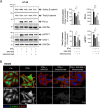The tumor promoter cysteinyl leukotriene receptor 1 regulates PD-L1 expression in colon cancer cells via the Wnt/β-catenin signaling axis
- PMID: 37316937
- PMCID: PMC10265834
- DOI: 10.1186/s12964-023-01157-6
The tumor promoter cysteinyl leukotriene receptor 1 regulates PD-L1 expression in colon cancer cells via the Wnt/β-catenin signaling axis
Abstract
Immunotherapy targeting programmed death-ligand 1 (PD-L1) or PD-1 in solid tumors has been shown to be clinically beneficial. However, in colorectal cancer (CRC), only a subset of patients benefit from PD-1/PD-L1 treatment. Previously, we showed that high cysteinyl leukotriene receptor 1 (CysLT1R) levels are associated with poor prognosis in CRC patients. Recently, we have revealed the role of the tumor promoter CysLT1R in drug resistance and stemness in colon cancer (CC) cells. Here, we show the role of the CysLT1R/Wnt/β-catenin signaling axis in the regulation of PD-L1 using both in vitro and in vivo preclinical model systems. Interestingly, we found that both endogenous and IFNγ-induced PD-L1 expression in CC cells is mediated through upregulation of CysLT1R, which enhances Wnt/β-catenin signaling. Therapeutic targeting of CysLT1R with its antagonist montelukast (Mo), as well as CRISPR/Cas9-mediated or doxycycline-inducible functional absence of CysLT1R, negatively regulated PD-L1 expression in CC cells. Interestingly, an anti-PD-L1 neutralizing antibody exhibited stronger effects together with the CysLT1R antagonist in cells (Apcmut or CTNNB1mut) with either endogenous or IFNγ-induced PD-L1 expression. Additionally, mice treated with Mo showed depletion of PD-L1 mRNA and protein. Moreover, in CC cells with combined treatment of a Wnt inhibitor and an anti-PD-L1 antibody was effective only in β-catenin-dependent (APCmut) context. Finally, analysis of public dataset showed positive correlations between the PD-L1 and CysLT1R mRNA levels. These results elucidate a previously underappreciated CysLT1R/Wnt/β-catenin signaling pathway in the context of PD-L1 inhibition in CC, which might be considered for improving the efficacy of anti-PD-L1 therapy in CC patients. Video Abstract.
Keywords: Colon cancer; Cysteinyl leukotriene receptor; PD-L1; Wnt/β-catenin.
© 2023. The Author(s).
Conflict of interest statement
The authors declare no competing interests.
Figures






Similar articles
-
Cysteinyl leukotriene receptor 1 promotes 5-fluorouracil resistance and resistance-derived stemness in colon cancer cells.Cancer Lett. 2020 Sep 28;488:50-62. doi: 10.1016/j.canlet.2020.05.023. Epub 2020 May 28. Cancer Lett. 2020. PMID: 32474153
-
Blockage of PD-L1 by FERMT3-mediated Wnt/β-catenin signalling regulates chemoresistance and immune evasion of colorectal cancer cells.Clin Exp Pharmacol Physiol. 2022 Sep;49(9):988-997. doi: 10.1111/1440-1681.13685. Epub 2022 Jun 28. Clin Exp Pharmacol Physiol. 2022. PMID: 35672907
-
WNT/β-catenin regulatory roles on PD-(L)1 and immunotherapy responses.Clin Exp Med. 2024 Jan 27;24(1):15. doi: 10.1007/s10238-023-01274-z. Clin Exp Med. 2024. PMID: 38280119 Free PMC article. Review.
-
TRIB3 Interacts With β-Catenin and TCF4 to Increase Stem Cell Features of Colorectal Cancer Stem Cells and Tumorigenesis.Gastroenterology. 2019 Feb;156(3):708-721.e15. doi: 10.1053/j.gastro.2018.10.031. Epub 2018 Oct 24. Gastroenterology. 2019. PMID: 30365932
-
The effect of Wnt/β-catenin signaling on PD-1/PDL-1 axis in HPV-related cervical cancer.Oncol Res. 2023 Jan 12;30(3):99-116. doi: 10.32604/or.2022.026776. eCollection 2022. Oncol Res. 2023. PMID: 37305016 Free PMC article. Review.
Cited by
-
High Oestrogen receptor alpha expression correlates with adverse prognosis and promotes metastasis in colorectal cancer.Cell Commun Signal. 2024 Mar 28;22(1):198. doi: 10.1186/s12964-024-01582-1. Cell Commun Signal. 2024. PMID: 38549115 Free PMC article.
-
A novel long non-coding RNA XLOC_004787, is associated with migration and promotes cancer cell proliferation by downregulating mir-203a-3p in gastric cancer.BMC Gastroenterol. 2023 Aug 12;23(1):280. doi: 10.1186/s12876-023-02912-2. BMC Gastroenterol. 2023. PMID: 37573302 Free PMC article.
-
1,4-dihydroxy quininib activates ferroptosis pathways in metastatic uveal melanoma and reveals a novel prognostic biomarker signature.Cell Death Discov. 2024 Feb 10;10(1):70. doi: 10.1038/s41420-023-01773-8. Cell Death Discov. 2024. PMID: 38341410 Free PMC article.
-
Wnt/β-catenin mediated signaling pathways in cancer: recent advances, and applications in cancer therapy.Mol Cancer. 2025 Jun 10;24(1):171. doi: 10.1186/s12943-025-02363-1. Mol Cancer. 2025. PMID: 40495229 Free PMC article. Review.
-
Immune Cell Migration to Cancer.Cells. 2024 May 16;13(10):844. doi: 10.3390/cells13100844. Cells. 2024. PMID: 38786066 Free PMC article. Review.
References
Publication types
MeSH terms
Substances
LinkOut - more resources
Full Text Sources
Research Materials
Miscellaneous

